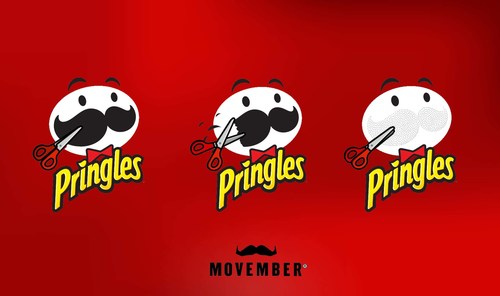5 insights from 5 inspiring partnerships

It can be difficult to maintain your momentum over summer.
The key way to tackle this is to keep inspired – to remember why you are doing what you are.
So we’re sharing these five partnerships to re-energise that why. To see the impact that is possible, and learn what we can from them in turn. Here are some of our favourites – we’d love to hear yours:
Pringles & Movember
Pringles and Movember have more than a moustache in common.
They share an audience, have similar brand voices and their messages exist to be shared. The fit couldn’t be stronger. So when Mr. Pringle shaved his iconic moustache, its no surprise that it caught media attention.
Movember saw an increase in people taking part in their shaving challenges and Pringles saw a 156% uplift in their sales. The partnership was able to create important conversations whilst also raising vital funds. Our favourite part is the simplicity of the tagline: Pop, Share, Chat.
This partnership teaches us to start our prospecting with shared purpose. Who cares about the people we care about?
LV and Family Action
These two organisations installed a number of telephone boxes in repair garages – giving men a place to talk about their feelings amid the cost of living crisis.
The two organisations know that men are less likely to look after their help – and often fear looking weak in front of their family. By creating a secluded space and offering a free helpline, they are offering a clear first step to break this taboo.
This partnership demonstrates the power of innovative thinking. How can corporate partners help you get in front of potential beneficiaries?
Carpet Right and Cats Protection
Cats are territorial creatures – they like to have a square of land to call their own.
To ensure that the cats in Cats Protection centres feels like they have a home to call their own, Carpet Right have donated a large number of carpet samples. These squares of carpet allow the cats to maintain their claws, mark their territory and get used to new surfaces.
What’s more, when cats are rehomed, they are able to take this carpet with them – supporting their transition to their forever home with something familiar.
This initial gift in kind has led to a campaign for #MatureMoggiesDay and we know more exciting partnership activities are brewing. This demonstrates one of the key principles of corporate partnerships – where you start a partnership with the mission, rather than the money, stronger partnerships are often built as a result!
Doritos & It Gets Better Project
Pringles aren’t the only crisp brand to make the cut. Doritos, a PepsiCo brand, ran one of our all time favourite campaigns with American charity It Gets Better project.
PepsiCo brands are well known supporters of the American diversity and inclusion movement, making Doritos a brilliant prospect for It Gets Better.
The two organisations worked together to build on PepsiCo’s historical work – demonstrating their shared commitment to the LGBT+ community by introducing Doritos Rainbows chips, the first Doritos product in history made up of multiple, rainbow-colored Doritos chips inspired by the Pride flag.
The reason we love the campaign is the #BoldandBetter hashtag. This partnership offered incredible reach and offered hope to those who may not otherwise see themselves represented. This is particularly the case in the school canteen, where a number of young people would have seen the doritos.
This partnership shows us the power of understanding what is going on in the corporate market. With diversity and inclusion becoming a growing priority, how can you help a company stand out?
Budweiser and SolarAid
Budweiser have recently launched their partnership with SolarAid – encouraging their audience to watch a full advert for the beer in order to trigger a free donation to their charity partner.
The banner reads “this ad lights homes”. By using advertising technology, Budweiser are able to engage their customers with their shared values. The impact of the partnership is huge, too. The initiative will help donate over 6,100 solar lights, reaching 33,200 people and saving families a total of £981,500.
This partnership teaches us that solving company problems – such as audience constantly skipping advertising – can create powerful partnerships.




